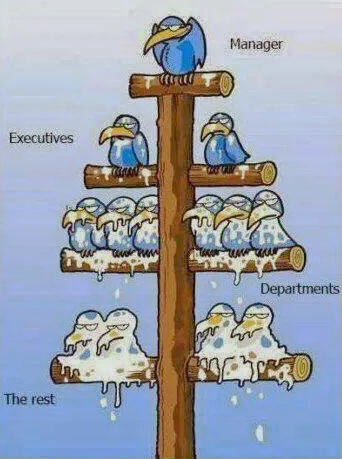
Social Status Matters?
Well, it depends.
Our species, Homo sapiens, is a social species. What comprises our Homo primate society is a network of entangled subconscious minds, nothing more. Since there are no separate, material executive facilities or functionalities directing social behavior, the stuff of a society itself is invisible, massless. Its network has no inertia, an attribute demonstrated to you personally whenever your trust in another is betrayed. It functions with unknowable computing apparatus using unknowable software located at every node of the network of individuals, no two software programs the same. The organ of social behavior is situated completely within the human cranium.
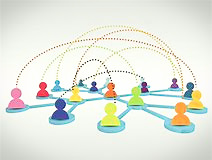
The invariant wetware orchestrating human society behavior, provided by the invariant human genome, resides in pieces and parts distributed in powerful subconscious minds which post the task-action imperatives of culture on the teleprompter in your brain. Since everything about social behavior emanates from the subconscious minds of its members, making the connection of “culture” to the human genome is a no-brainer.

Culture
The structure and operating wetware of a Homo society, its culture, has a variety of definitions offered up discipline by discipline. After 150 years, the definition of Homo culture is still contested within its originating discipline, anthropology. Over the very long term, since cultural adaptation is genetic, species evolve. Over the short term, members of a species adapt to the environment through behavioral changes “learned” from catastrophic social experience.
Groups gradually accumulate cultural information of varying degrees of utility. When considered as a socially transmitted information pool associated with a particular population, we can speak of a culture. The information package that constitutes a Homo culture is lodged in the incredible, unknowable subconscious minds of its members. All culture is subject to 2nd Law degradation. The ongoing COVID-19 episode demonstrates to everyone that no society gets a hall pass from the indifference of natural law.
Without a technologically-solid reference standard of a “best” culture, the editing and filtering of piecemeal cultural information is a blind-drift, hit-or-miss proposition. It establishes an arena of informational conflict and endless debates filled with error and missed ecological opportunities. Social structure underwrites social culture. Since society doesn’t have a specified destination, any path gets it there.
The virus of social progress
As history shows, there is a terrible drag on attempts to advance a society. What are patently obvious goals for society to attain keeps getting shoved aside for something valued higher than social prosperity. Rather than collaborating to take society up to higher levels of accomplishment and security, the members of society are instead preoccupied in intramural competitions over social ranking. What does hierarchical rank have to do with collective prosperity? Absolutely nothing.
Much time is invested in social cognition, managing how we rank with other people busy managing how they rank. Our subconscious makes guesses instantly about trust, honesty, class, motives, and opinions. It continually fabricates a story about the people around us. It makes guesses about the efforts of others. We attribute their social behavior to a particular cause by reflex. Every subconscious mind functions with a vast repertoire of cognitive biases.
The status quo bias is one type of cognitive bias that involves people preferring that things rank-wise stay as they are, that the current state of affairs remains the same. A status quo bias causes people to miss out on benefits that far outweigh the risks. The imagined potential for loss in status stands out in people’s minds much more prominently than the potential for gains. The status quo bias can impact on significant life choices about your finances, your politics, and your health.
To be relevant to species survival, the imperatives of social culture must constantly be questioned and updated. Successful cultures are those that can rid themselves of information that has passed its “sell by” date. Preferential attention to the high-performers of a collective revises culture by editing out ineffective practices in favor of practices that deliver. Even so, GIGO predominates. Without a “best” reference benchmark, fiction of all sorts freely enters the information pool in which social behavior operates. As everyone in a society knows, even its goal statements are fiction.
Culture is not automatically transmitted intact by socialization. Ethnographic records exaggerate the effectiveness of cultural knowledge because ethnographies can be written only for societies that are successful, that is, societies that still exist. Even successful-seeming cultures are studded with misinformation and plagued with GIGO. Informational domains in which corrective feedback for entropy extraction is lacking become populated with ineffective and maladaptive beliefs and practices. Even though invisible, all networks and cultures are subject to 2nd Law erosion.
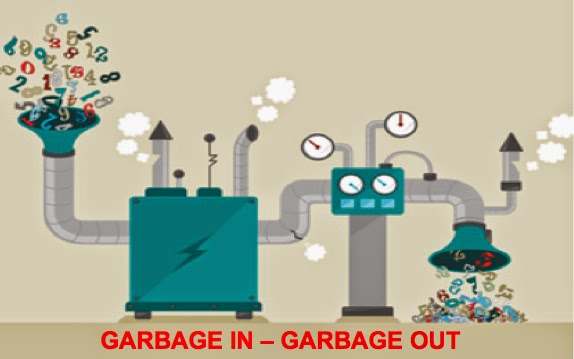
Hierarchy
Although affiliative and cooperative interactions form the primary fabric of human social relationships, group living necessarily entails conflict over divergent goals in kind and degree and contrived zero-sum competition over everything. The larger the collective, the more opportunities for conflict there are (multiplicity). The formation of social hierarchies, an organizational structure observable across many species in the animal kingdom and ubiquitous to human groups, is the default to deal with these multiplicity-driven conflicts. To form large collectives, human beings instinctively hierarchize.
Truth be told, we are a fickle species in a shifting mix of sentiments involving multiple and complex psychological and hormonal mechanisms orchestrated and performed exclusively and entirely by the subconscious mind. An attempt to organize this unknowable cacophony requires tradeoffs. You can have the predictability of organization or you can have autonomy. You cannot have both.
Understanding the need to form social pecking orders is part of understanding social dynamics. Social hierarchy means forming vertical social stratification – the castes, ranks, and classes that form the scaffolding of large-scale, steep society. Social structures are 100% psychological. Social strata are identified materially by the language of the stratum and its symbols, nothing else. A coat of arms is not part of the psychological machinery in the brain.
Although the bases on which humans form hierarchies and allocate rank are diverse, hierarchies animate a social structure in which high-ranking individuals reliably receive greater authority, deference, attention, and resources than low-ranking others. Accordingly, the paramount value of the ruling class, how it spends its energy, is devoted to changing rank and resisting changes to rank.
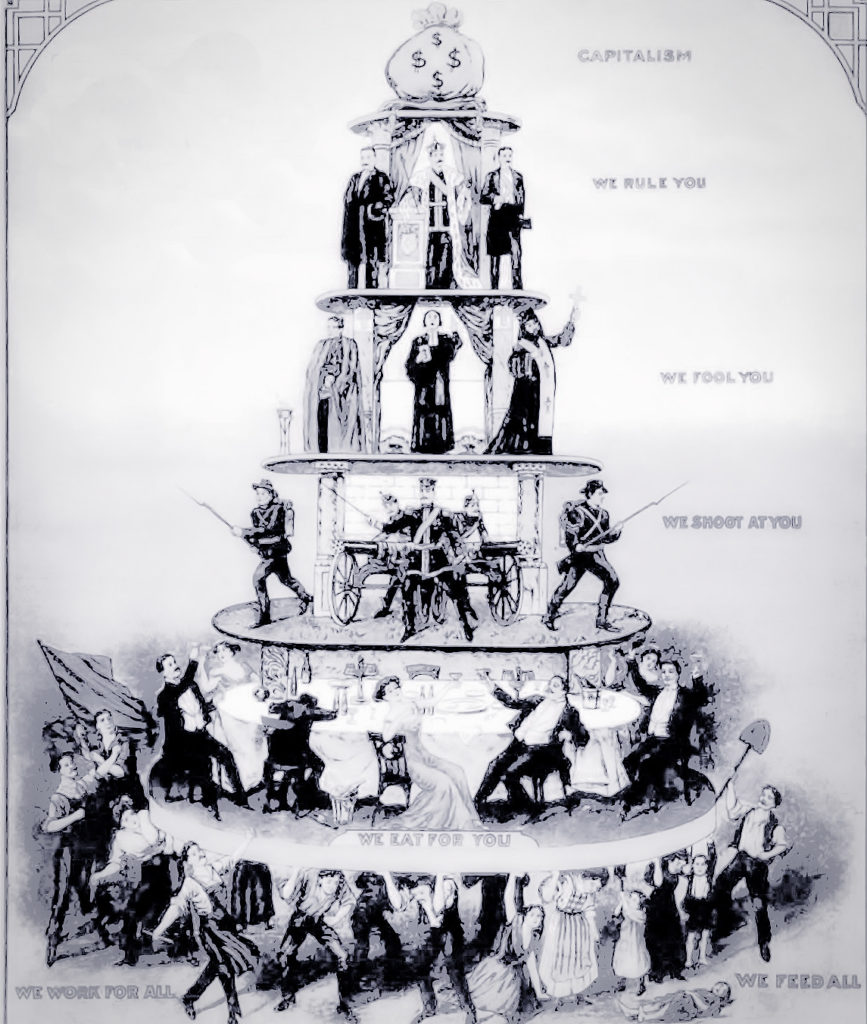
Roles of rank
Hierarchy structurally decomposes the challenge of group performance responsibility into a vertically stacked series of handoff roles, with each level of a hierarchy having a unique role and vocabulary in connecting the goal-dream to its realized attainment. The executive level, wholly consumed by social status competition, hands off its goal description to functional levels of hierarchy in the language of whim and fancy reserved for visionaries. The progression of goal-attainment responsibility handoffs transforms amorphous platitude into local and specific implementation tasks. In two handoffs from the CEO, the responsibility for social prosperity has already and completely disappeared. Watch any Congressional hearing.
The progression of handoff interfaces translates the top, abstract platitudes in functionality along with class-established vocabulary and grammar so that the people doing the work are given specific tasks they can actually perform. Each interface between levels, as it is in any vertical communication system, is a hot spot for goal creep and translation error. By the time the responsibility for goal attainment lands on the workforce, the vision expressed by the head shed is unrecognizable.
Since the design and assign of worker task action is done one level up from labor, the Workmaster level, it becomes the final handoff of outcome responsibility where the virtual rubber of “vision” meets the material roadway of reality. The functionality that translates general abstractions to physical functions to part numbers, entirely creative, is called the Franceschi Fitting. Rule-based behavior is anathema to this essential hierarchical process.
On two occasions I have been asked, “Pray, Mr. Babbage, if you put into the machine wrong figures, will the right answers come out?” I am not able rightly to apprehend the kind of confusion of ideas that could provoke such a question. Charles Babbage
Without the progressive, high-fidelity translation of organizational goal statement into the tangibles of parts and workplace tasks, nothing happens. This interpretation cannot be done by management because of bad information quality and preoccupation with zero-sum social status tournaments. It can’t be done by labor because of insufficient span of knowledge. In practice it takes genius to translate generalized functions into physical functions and it takes generous amounts of experience and creativity to turn physical functions into catalog numbers and assembly instructions. The genius part is usually from general staff while the creative implementer of record is always the Workmaster/foreman.
Proceeding without a robust, explicit Franceschi Fitting (FF), commonplace, is the borrowing of trouble. When no one has responsibility for translation fidelity and no one has legitimate responsibility for goal attainment, what you get is escalating crisis. As the only responsible definition of “goal,” the FF is the measure of outcome responsibility.
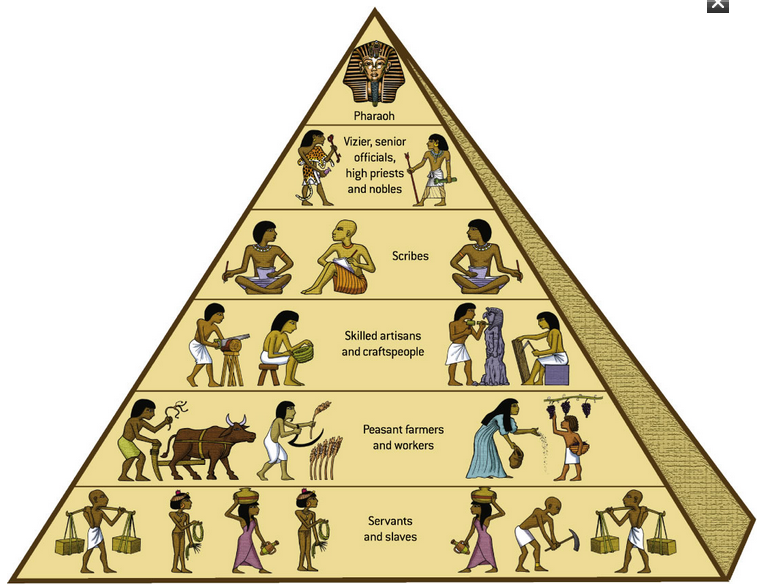
Status management
In order to function in groups with status hierarchies, it is imperative that individuals agree who is ranked where. It is thus a requirement that individuals can make informed decisions to assess their own and other’s social status and to behave in ways appropriate for their status position. Members of a group have an uncanny sense of who ranks where in a hierarchy and this sense is a stabilizing mechanism to facilitate social cooperation and group cohesion.
In a hierarchy, social rank considerations paramount at the top, each social class seeks to keep itself clearly distinct from the classes beneath it, which is why the top ranks happily indulge in conspicuous consumption. In practice, the higher class induces the lower class to engage in contrived, baseless zero-sum competitions. The mathematical physics of zero-sum transactions, the platform of casino gambling, assures that the upper class always wins.
Status hierarchies, a ubiquitous and fundamental feature of social life, are tied to individual welfare. Individuals accorded higher status are given more respect and influence, enjoy more control in their social environment, more freedom and autonomy in determining their own behavior, higher subjective well-being, better health, and longer lifespans. Individuals with lower status are given less respect and social attention, have less control, face more constraints on their behavior, experience lower self-esteem and happiness, and suffer more from work-related mental and physical illness. However, initiating or threatening force or deception against a person or his rights is always morally illicit.
Status-assigning processes are multifaceted and complex, and diverse kinds of individual differences play an important role in determining status hierarchies in groups and face-to-face interactions. Perceptions (subconscious) of value, not actual value, drive status conferral. Social hierarchy rank is intimately related to self-esteem, and as conspicuous consumption boosts self-esteem, the low classes become invisible.
While an extensive literature covers a wide range of micro-level attributes and behaviors that influence social rank attainment, there is no coherent, unifying framework integrating the various data collections into a comprehensive and theoretically-supported understanding of rank differentiation. A substantial body of evidence has intimidation and performance co-existing as two fundamental yet distinct platforms of rank differentiation in human societies. Both avenues persist in contemporary human groups, and produce patterns of behaviors and tactics that effectively promote influence over others, even when wielded within the same social group. Sociologists have a simple distinction of these status-attainment strategies:
- Coerced deference to dominant others who induced fear of physical or psychological harm (i.e., Dominance). Opinion is the global standard of the head shed. Authority is conferred before the fact of performance. Authoritarians are called entitled consumers.
- Freely-conferred deference to those who possess and demonstrate valued skills and abilities (i.e., Performance). This is the global standard of the workforce. Social power, like trust, is always conferred after the fact and regularly updated.
In a society, social status is a distinct construct. Social rank is the prestige, respect, and deference that one has in the eyes of others. It is an index of the social worth that observers ascribe to an individual or a group. Status is wholly reliant on the opinions of these observers, it is the outcome of their subconscious mind evaluation process, done in a centisecond.
We evolved in living situations in which the neurophysiological bases of our social behavior were always in flux. Agonism was and is our last resort when all other efforts for us to maintain our relative standing fail. Because we each participate in multiple social arenas, we subconsciously strategize in our daily interactions. Much of cultural learning is directly relevant to everyday experience. Knowledge of relative standing and skill-level are public and generally reliable.
The human subconscious is equipped to make instant decisions about who to trust (cheater detection) or which individuals are genetically related (kin detection). It manages status hierarchies. The status detection system of the subconscious mind includes mechanisms to extract relevant cues in the environment to assess their own status and that of other individuals, mechanisms to behave in ways that are afforded by their status, mechanisms to improve their own relative status, and mechanisms to undermine the status of competitors.
Domination
Dominance entails the induction of fear through intimidation and coercion to attain or maintain rank and influence. It is homologous with dominance hierarchical systems in nonhuman primates that result from agonistic zero sum contests. In humans, dominance can be observed in dyadic social relationships based on coercion, such as those between police and citizen, bully and victim, or boss and employee, as well as in larger social structures. Dominant individuals effectively instill fear in subordinates, typically through threats to their security that are more psychological than physical.
Those with formal institutional authority, such as employers, can evoke fear in subordinates with impunity by threatening to punish them. Subordinates respond to this betrayal of trust by thwarting the intentions of the dominant individuals to have it both ways. The conflict between those that exercise vested authority and those that control prosperity guarantees social conflict.

All research on organizational effectiveness has found that “pressure” tactics—those involving the use of demands, threat, and intimidation to influence others are highly counterproductive. The Dominance account holds that force and intimidation leads to submission and the conferral of influence and rank, but neglects the instinctive, instant-reflex counterattack to coercion all humans exhibit. Because subordinates of Dominant leaders accumulate angst out of fear, their “status” is associated with quiet sabotage and the withholding of efficiency in productivity (Ca’canny).
Both domination and performance groups are underpinned by distinct psychological and behavioral patterns, which allow their adopters to effectively intimidate (in the case of Dominance), or garner respect and admiration (in the case of performance). The pursuit of dominance and performance are separate activities with different suites of interpersonal behaviors, personality traits, competencies, languages, and emotional mechanisms. Performance-esteemed individuals demonstrate locally valued competencies and skills that have measurable group benefits. Dominant individuals garner contempt.
There is nothing on the upper class value system that coincides with the value system of the workforce. The differences are differences of kind, not nuance. The dominant class is preoccupied with rank-changing palace politics, a theater of delusion. The workforce is all about implementation and performance towards social prosperity, quantitatively-measurable attainments.

Dominance is associated with a disregard for the well-being of workforce, creating insecurity and anxiety. Individuals who pursue dominance are fueled by arrogant, conceit-based “hubristic” pride, whereas those who pursue goal attainment are fueled by a pro-social, competence-based “authentic” pride – the instinct of workmanship manifest.
Because dominance is the global operational standard of distrust, hierarchical relationships in humans are shaped by interactions involving threat and intimidation, a perceived ability to inflict harm. Direct or indirect displays of physical, psychological, or verbal aggression are the primary routes through which dominant-oriented individuals sacrifice trustworthiness attempting to attain influence. The highest-level of abusive behavior is displayed by those who are incompetent and insecure in their role. When cooperation is essential to be effective, following a dominant leader is counterproductive.
Since personality dominance is associated with higher rank groupthink, trait dominance is one of the most robust predictors of authority rank, outperforming a myriad of other traits including conscientiousness and intelligence. King of the hill of authority, completely untrustworthy, is a rank unrelated to hierarchical power, managed and allocated by trust.
Performance
The ranking influence of performance is willingly granted to individuals who are recognized and appreciated for their skills, attainment, and knowledge. Members seek out the opinions and company of effective goal-attaining individuals in efforts to imitate and learn their superior skills or knowledge. As a result of their performance, the highly-effective members are conferred with influence and rank. High rank by perceived competence and performance can occur at any hierarchical level. Learning from the most skilled group members is a low-cost way of acquiring fitness-maximizing knowledge.
The assumption that performance represents a fundamental path to rank attainment in humans is consistent with the predominant view of rank attainment within social psychology. Because these two strategies are the products of distinct selection pressures, they associate with distinct underlying instincts, psychological processes, and patterns of behavior.
Once again, domination is conferred by fear, directly connected to workforce anxiety. Performance is conferred by measurements of task action results. Demonstrated expertise readily and freely confers rank in locally-valued domains.
The role assigned to performance-based social status is to facilitate making goal-seeking decisions in a peaceful, effective, and logical manner. Beneficiaries confer status as currency to compensate those providing a great deal of value to the collective (reciprocity). When individuals are accorded higher status, they become more committed to their group. This validates the causal role of status on group commitment.
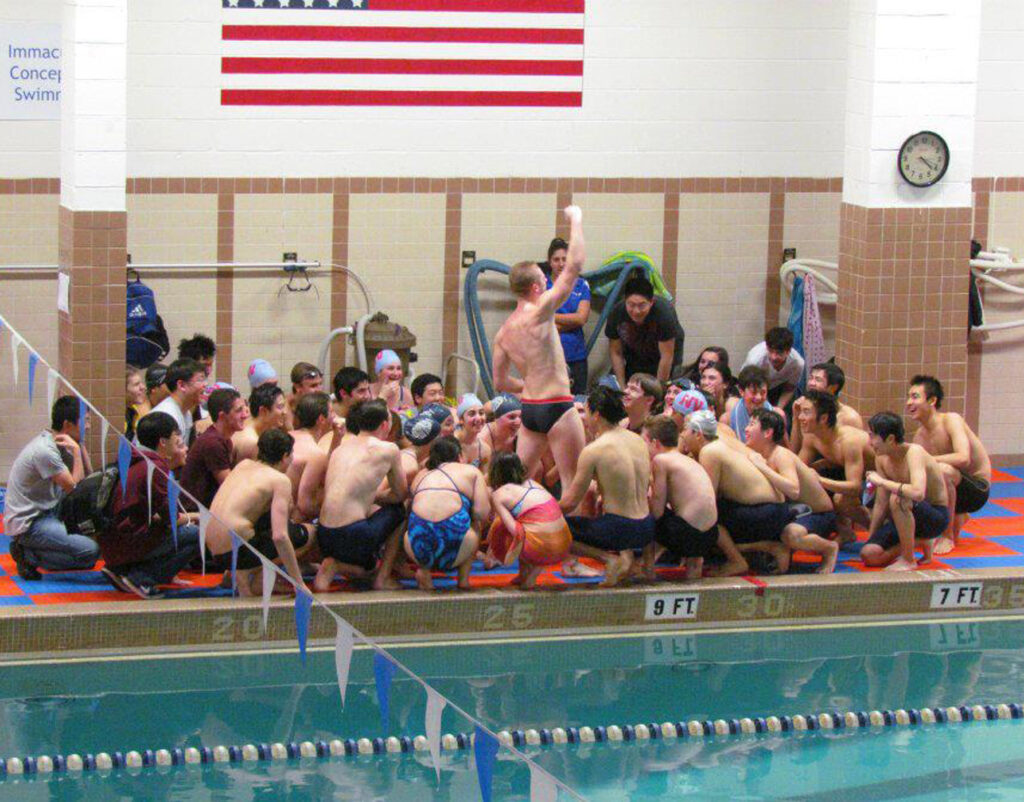
Rank Management
Although social rank is a fundamental factor in human behavior, to be sure, conceptualizations of social rank are as muddled as any in psychology. From the most egalitarian to the most hierarchical human society, individuals who acquire more rank, by dominance or performance, benefit. In small-scale societies, rank-leveling coalitions and household mobility restrict the opportunity for physically dominant individuals to coerce their way to power.
Practitioners in psychology, sociology, anthropology, political science, and other social disciplines view social rank as a fundamental feature of social life not only among human beings but among social species in general. Understanding rank as a prime mover of social behavior in a hierarchy is essential.
Status dynamics play out in the interpersonal relations among people. It arises from an interaction of social context, relationship variables, and individual personalities. As a result, a particular person might be accorded high rank by some members of a group but not by others for reasons that have nothing to do with structural considerations.

The essential foundation of trust lies in instrumental social value (or, more precisely, perceived instrumental social value). Workforce people are accorded status to the extent that others believe that they possess resources and/or personal characteristics that are important for the attainment of collective goals. People who, for whatever reason, are seen as promoting collective outcomes—and thus benefitting both the group as a whole and its individual members—are accorded higher rank than people who are not seen as promoting survival-worthy outcomes.
Rank is not a property of a particular position in a group or society. You can obtain high authority with domination, but opinion and zero-sum competition results determine your status. Mere possession of a high rank position can lead others to infer that you have instrumental social value, whether or not that is actually the case. In organizations, teams, and task-oriented groups, rank by performance is directly related to the degree to which members are perceived to contribute to collective outcomes.
Any social encounter or interpersonal relationship can be characterized in terms of the degree to which each individual is perceived as having instrumental social value (rank, respect) and relational value – trust. Status is neither a property of a person or a position but an inference that others draw or a social designation that they confer. Based on their judgments of an individual’s contributions to collective outcomes—his instrumental social value—people confer rank.
Esteem by performance accrues automatically without the status beneficiary deliberately trying to accumulate it as people contribute to collective outcomes. A fair-minded, judicious, and loyal group member can accrue esteem as other members come to recognize the important role that he plays in the group.
The role of roles
Status hierarchy among men is a human universal. Wrestling over differences in social rank is a routine part of human social life. Hierarchies represent tacit agreements to facilitate exchange while avoiding the overhead costs of incessant discord. Every level in a hierarch has a unique role, not determined by the big kahuna, but by Nature. The roles stacked and acting in synchronization and collaboration are what, exactly, makes a social system viable. When role occupants all fill their role, the organization works. When they don’t, things go to hell.
Roles carry with them expectations, prescriptions regarding the performance of those who inhabit those roles are to maintain. Failure of due diligence prescribed for a role results in loss of esteem and compromises the right to exercise the role. These role based images are not a facsimile of the person’s characteristics. Roles are functions.
Observing the inappropriate and often regressive behaviors that occur in backstage areas shows how much of people’s role-based behaviors are maintained by self-presentational pressures to convey an appropriate image. People demonstrate their instrumental social value directly through actions that benefit the group rather than simply through posturing.
People who desire both status and acceptance from the same audience face a dilemma and people seem to know this. In fact, the more people want to be accepted, the more they underestimate their status. People recognize a trade-off between social acceptance and social rank and choice for acceptance and belonging can override their desire for rank.
People can contribute to collective outcomes not only through their competence and provision of material resources but also by fostering positive relationships among group members. People enjoy memberships in groups in which they have positive relationships because cohesive groups perform so much better. Thus, people who foster a positive group climate develop instrumental social value.
General remarks about social status designations
Humans allocate social rank regarding positive social power on the basis of respect and admiration of performance. It is miles apart from force and coercion of zero sum competition. These two systems of rank allocation, authority and performance, are underpinned by distinct psychological processes, behaviors, and neurochemistry which were selected over long, protracted evolutionary pressures.
Status conferral involves a direct role for cofactors and observers. While there are punishments by which authority-holders can siphon authority from their interaction partners, there are no such avenues when it comes to performance status. If interaction partners and observers do not bestow status on a target, it doesn’t happen. This differentiation is reflected in power and status dynamics among national leaders: Presidents can build and maintain power through the infusion of financial or military support from foreign countries, but they must rely on the views of their own people in order to build and maintain high status among their constituents. Examples are everywhere.
Since either way rank depends on others, concerns about maintaining one’s status will orient domination status-holders outward, as they focus on the status-conferral process. High-status parties (who presumably wish to maintain their high-status position) will be particularly vigilant.
Domination liberates people from social and normative pressures and enables them to shift their focus inward toward their own goals and dispositions. Drive management can also prompt an egocentric orientation to social encounters. It reduces concern about others their opinions. They will have no other perspective than their own.
In collective decision making, since individual members possess different perspectives, conflict is inevitable. Disagreement over the group’s goals and the appropriate strategies to pursue those goals is incessant.
There is an interaction between status and power. Their combined, integrated effects can determine outcomes. Authority is negatively associated with fairness and positively associated with unfairness. Lack of concern for others is the trademark of perceived high authority. Authority hierarchies engage in intramural competition for rank that curtails concerns about achieving group goals. The positive effect of performance status on prosperity does not emerge when domination drives are high.
Groups with steeper status hierarchies fare worse than those with flatter and more egalitarian structures, both in terms of performance and group members’ attitudes. There is a negative correlation between hierarchy steepness and member satisfaction. Status hierarchies always lead to worse group outcomes rather than better. Head-shed people defend failed decisions, such as M&A, investing further in those disastrous decisions.
The Hormone framework of social behavior
Social status hierarchies are a fundamental dimension of social life and critical to social system survival, to be sure. The mechanisms of action of social behavior reside in the subconscious mind. The subconscious mind also has exclusive control of your hormone system. History has shown the subconscious mind can’t resist meddling with your social behavior by orchestrating your hormone production to suit its fancy.
Accordingly, phylogenetically-conserved biological machinery that relies on serotonergic and dopaminergic neural signaling play key roles in regulating brain circuitry associated with the maintenance, regulation, and reciprocity of social rank cues. Cultural norms and values that explicitly or implicitly reinforce distinct repertoires of social status behaviors within groups drive the neural variability in response to social status cues across human populations. The entire affair of endocrinology and social rank is conducted in secret within the subconscious mind.
The field of social endocrinology, which includes the intersection of behavioral endocrinology and social-personality psychology, provides insights into the role of dynamic, hormonal systems in regulating these behaviors in pursuit of rank in any hierarchy. For over 150 years, hormones—chemical messengers secreted from endocrine glands that communicate with systems throughout the body including the central nervous system—have been studied in animals as effectors of physiological and behavioral change.
The neuroendocrine systems that influence and respond to the behaviors that govern social rank are many. Hormones can regulate social behavior, with testosterone and cortisol moving things social in one direction, and estradiol and oxytocin, moving things social in another.
The human endocrine system plays such a direct role in social behavior, it is dereliction of duty to leave it out of the calculations of social dynamics. The endocrine system not only responds to social activity, its organic pharmacy can supercharge the activity it responded to. By bloodwork alone, social behavior and the health of the participants can be described. No psychological investigation is necessary. Think you can alter your bloodwork by conscious-mind gymnastics?
Bad news
Social endocrinology research has focused almost exclusively on dominance as a popular behavioral route to individual rank attainment. Higher levels of circulating testosterone (T) are associated with increased dominant behaviors in several animal species. High-T humans who lost status perform poorly on complex cognitive tasks, pay more attention to status cues, and exhibit increases in negative affect. High-T individuals who gained status show the opposite pattern of response, performing well on complex cognitive tasks, paying less attention to status cues, and showing no signs of increased negative mood.
Cortisol levels are companion to T and tie dominance to stress. High cortisol levels attending high T, when sustained, are extremely detrimental to human health. As Brainiac would have it, behavior and the social environment influence T levels. This reinforcement process can lead to dramatically fast changes in social behavior, troubling changes in behavior witnessed by every human.
Low levels of T attend individuals with little interest in social rank struggles who find high-status positions aversive. In a Plan A organization, when high T fails to increase your social status, your subconscious mind calls for more T and cortisol. Basal T taps into a person’s chronic status-seeking motivation, analogous to a personality trait, whereas short-term changes in T tap into a person’s status-seeking motivation, analogous to mood.
Physical and psychological stress stimulates a hormonal cascade, wherein the hypothalamus secretes corticotropin-releasing hormone (CRH), which stimulates adrenocorticotropic hormone (ACTH) to be released from the anterior pituitary, which finally stimulates cortisol release. The primary function of cortisol is to mobilize glucose to fuel the “fight or flight” response to stress and enhance cardiovascular functioning. Thus, cortisol release is a useful and adaptive response to stress in the short term that physiologically prepares the body for the rigors of reacting to a stressful experience.
Stress blocks deliberative thought processes and leads to rule-based, automated decision making, increasing risk-taking in loss domains and increasing conservatism in gain domains. Given the absolute need for reflective deliberation in the decision making process, rule-based automatics lead to negative consequences.
Cortisol is an integral part of the body’s physiological reaction to stress exposure. Overexposure to cortisol due to chronic stress disrupts the negative feedback loop, leading to cyclically increasing cortisol concentrations and a generally dysregulated physiological response to stress. When impairment of the negative feedback loop results in excess hormone secretion, cortisol itself becomes a liability, with its deleterious effects including neural atrophy, poor immune functioning, and cardiovascular disease.
In the operational reality of social hierarchy, the working class sacrifices its own health to support the organizational dysfunction that sickens them. The lack of control over stressors produces substantial increases in cortisol overriding those directly controlled or predictable by an individual.
The serotonergic system is implicated in the determination and maintenance of social status within a hierarchy. Serotonin is critical for the regulation and expression of social domination. It serves to dampen aggressive behaviors and enhance affiliative behaviors toward others.
Dominant individuals tend to respond antisocially to stressors, which in turn begets further interpersonal hostility. Hostility underlies the cyclic and detrimental nature of stress and low status. Persistent stress leads to the development of a hostile nature that in turn invites additional provocation from others, becoming an added stressor in itself. Social status has immediate consequences for cortisol functioning. The associated increases in testosterone and decreases in cortisol is part of a unique neuroendocrine profile that underpins dominance and rank-seeking behaviors.
Humans benefit from social support (trust-based), which results in lower-basal cortisol concentrations and a reduction in the cortisol response to stressors. Unreliable social networks and perceptions of social isolation (distrust) are stressors in themselves.
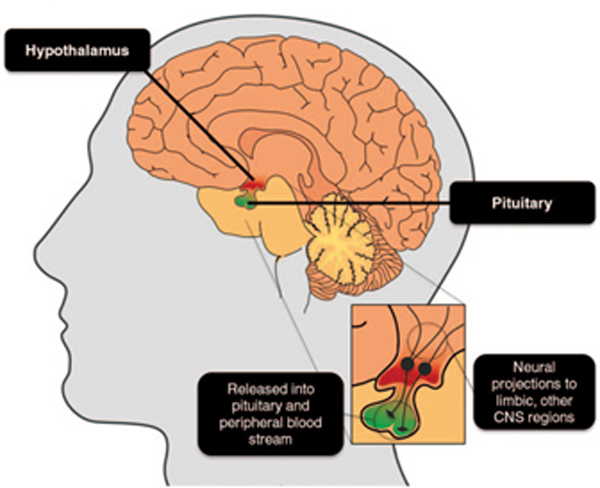
Good news
Oxytocin is a neuropeptide hormone produced in the hypothalamus and secreted from the posterior pituitary that is a neuroendocrine modulator of social behavior and social cognition. In a social context, oxytocin only promotes prosocial behaviors directed toward in-group members. So rather than directly affecting an individual’s status like testosterone or estradiol, oxytocin affects behaviors related to improving the well-being of one’s in-group. Oxytocin increases trust, generosity, and cooperation in choice-making. It increases interpersonal perceptions of trustworthiness and attractiveness. Exogenous oxytocin also affects social cognition, improving memory for positively valenced faces. So rather than affecting an individual’s status like testosterone or estradiol, oxytocin affects behaviors related to improving the esteem of one’s group by performance
Oxytocin’s influence on behaviors and psychology that benefit the in-group in competitive and noncompetitive settings result in promoting an group status. The hormone improves group dynamics, specifically altering behavior related to the process of forming a group and to cohesiveness and collaboration within a group. The effects of oxytocin do not depend on the extent of the differences between in-group and out-group or on the inherent importance of the in-group to an individual. Instead, oxytocin stimulates these prosocial behaviors across a variety of in- and out-groups. Elevated levels of oxytocin increase protective behaviors toward an in-group and positive cognitive associations and decisions with in-group members.
Oxytocin surges are increased in well-regarded, high-status individuals as they experience more prosocial interactions and positive attention from members. Your individual status affects your oxytocin concentrations, especially within stable, decorous hierarchies. We ourselves have, over time with Plan B, become oxytocin surge addicts. It’s how we know for ourselves that we have reached transcendence. When the positive reciprocity stage is reached, our comrades get hooked as well, and so on. It’s all good.
Vasopressin improves social memory and cooperation but, unlike oxytocin, vasopressin augments the cortisol response to social stressors. The effects of testosterone on certain aspects of status may depend on an interaction with vasopressin. This low status hormone pharmacy is associated with increased morbidity and mortality from cardiovascular disease, Type-2 diabetes, and obesity.
Status determination computational modules in the brain
The ability to recognize, maintain, and navigate social-status signals in the environment is crucial for individual and group survival. Without proper understanding of the social role expectations and rules for one’s self and other group members, the rituals of obtaining and distributing necessary resources from the environment become compromised. Detection of hierarchical social interactions emerges during infancy.
The development of the ability to regulate one’s behavior is a crucial milestone for social status cognition, as impulses and habits of the individual become more controlled, sensitized, and responsive to environmental or cultural demands. In the end, social status depends upon the opinions of others.
In order to appropriately process and react to hierarchical information, neural systems exist in your brain that distinguish between high and low-social ranks in both stable and unstable hierarchical settings. In stable hierarchies, where hierarchy-related conflicts are minimal, social ranks are established and unchanging. Hierarchical unrest, resulting from fluctuation of group members or group conflict, render the hierarchy unstable and authority competition takes the stage.
Recognition of others’ relative ranks within a hierarchy depends on one’s ability to contextually encode the association between hierarchical status and the particular person to whom it pertains. In humans, its activity increases in response to faces that are highly associated with a context (e.g., famous faces) compared to faces that lack contextual association.
Within both stable and unstable interactive hierarchies, the human cortex is preferentially activated by viewing a relatively superior individual, suggesting that the neural processing of the contextual association between status and person is greater for high status compared to low status individuals. Social norms that determine permitted, obligated, or prohibited behaviors are defined and maintained by groupthink hierarchies, and importantly, dominant individuals are responsible for punishing social norm violators. Differential social status-related activation in several other brain regions, however, occurs only during periods of hierarchical instability, when change in rank is possible.
High authorities view people through the lens of agency. While these aggressive postures can increase production in the short-term, they damage relationships, obliterate trust, and reduce morale. In this way, the compulsion to objectify and abuse workforce people leads to negative interpersonal and continual organizational consequences.
During periods of instability, social ranks within a hierarchy can be redefined based on particular competitive performance-based outcomes or circumstantial incidents. Such a “hierarchically valuable” event can be either positive or negative for a given individual depending on the impact it has on his current social standing. For example, within an unstable hierarchy, outperforming a superior can increase one’s status and thus such an event is associated with positive hierarchical value. On the other hand, being outperformed by an inferior can cause a drop in one’s social ranking and is associated with negative hierarchical value. Alternatively, outperforming an inferior or being outperformed by a superior are events that do not carry hierarchical value because such outcomes do not change one’s status but rather reinforce the current hierarchical ranking.
Highly ranked individuals in a hierarchy are authorized to inflict pain (physical and emotional) on those of lower status. During periods of hierarchical instability, however, the individuals in superior positions are the ones with something to lose. A lower-ranked individual is capable of threatening the more superior position. The emotional pain felt by a higher-ranked person when outperformed by someone of lower status is greater in individuals who feel compelled to remain in the superior position of authority.
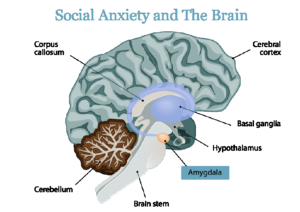
Retaliation that accompanies the outperforming of a superior figure, which is coded in the dorsomedial prefrontal cortex, plays an important role. Within an unstable hierarchical setting, several brain regions increase in activity including the anterior cingulate, dorsomedial prefrontal cortex, and motor areas.
The ability to accurately infer social status within a hierarchy is critical to survival. It occurs by decoding distinct kinds of nonverbal cues, such as facial and body postures. The capacity to both express and recognize social status from nonverbal cues represents a core social cognitive capacity supported by a number of distinct brain regions. Perceiving social status from the face occurs rapidly, approximately 170 ms, after the initial percept is shown within occipitotemporal regions of the face, including the fusiform and lingual gyrus. During more complex social tasks such as watching social interactions that involve authority rank compared to communal relations, the anterior portion of the superior temporal gyrus is also recruited. Neurons within this brain region codes for rank relations to a greater extent compared to horizontal social relations. Cultural values of social dominance hierarchy modulate neural response during social cognition.
The preference for social hierarchy modulates brain regions important for social cognition as well as empathy. Cultural norms reinforce social status signaling not only from nonverbal cues, such as body postures, but also from symbolic cues. While the brain does not compute gains in SES as intrinsically rewarding compared to fulfillment of social obligations or demonstrations of cultural competence more generally, nevertheless, SES affects how the brain processes information.
An individual’s perception of their relative social status or power can modulate how the brain performs cognitive tasks, such as mathematics. Even temporarily heightening a person’s sense of social power increases math performance, possibly by reducing cognitive interference. The experience of being high or low power modulates the neural basis of cognition and demonstrates the important influence of social status on how the brain computes.
Summary
There are but two kinds of social status: by authority and by performance. Authoritarians necessarily spend their lives in zero sum warfare with each other, who they can’t control, and an army of wanna bees. They delude themselves that high authority is convertible one for one with the social power to control what people do. They discover that in the operational reality, they only have the power to punish their lower classes. In time, they contract the imposter syndrome.
Those that care about benefiting society by their performance spend no time at all specifically aimed at grooming their social status. All they do is perform their role in a way that benefits themselves and their society. Their instrumental social value is conferred by society, not by winning competitions, and it is paid in the currency of social power. All the recipient has to do is get better at what he was doing, which is what he was striving to do in any case.
Verticality clues help define roles in a formal hierarchy, social influence among friends, privileges of behavior control granted by tradition (parents over children, husbands over wives), accomplishments or endowments in life (education, income), victory in real or symbolic competition, celebrity, respect accorded by others, or the personality trait of dominance, among others. Overlap between these concepts is great. Knowing who’s the “boss” makes it easier to communicate efficiently in order to achieve goals and maintain the existing social ranking.
People quickly, automatically, and effortlessly make judgments of others’ verticality and there is great consensus about who appears to have higher authority than whom. High level people are interested in knowing subordinates’ feelings, thoughts, or expectations. Members hold explicit and reportable beliefs (i.e., stereotypes) about the nonverbal signals of verticality and they apply these when judging others on this dimension. Engaging in behaviors activates neural circuitry consistent with those behaviors.
The vertical dimension is closely related to nonverbal communication. “Nonverbal communication” classifies the behaviors that people emit with their face, eyes, body, and voice (independent of the words), and people’s accuracy in perceiving others’ states, traits, and personal characteristics.
Views: 482

